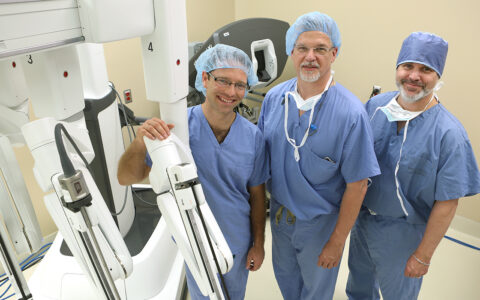Among researchers working to develop improved screening tests to support targeted diagnosis and treatment of prostate cancer is a team led by Jeffrey Tosoian, M.D., an assistant professor in the Division of Urologic Oncology at Vanderbilt University Medical Center.
This stage of development marks a new approach for diagnosticians.
“It’s a third generation of prostate cancer biomarkers,” Tosoian said. “The first generation was prostate-specific antigen [PSA], the second was MyProstateScore and other cancer-specific tests. The new model is focused on the high-grade cancers we really need to diagnose and treat. This has potential to substantially improve clinical practice, as well as patients’ experience of the screening process.”
“This has potential to substantially improve clinical practice, as well as patients’ experience of the screening process.”
While PSA is prostate-specific, it is not cancer-specific, Tosoian said. In nearly all men, the prostate enlarges with age and PSA rises along with that. While men with prostate cancer typically will have an elevated PSA, the majority of those with an elevated PSA do not have cancer.
Data from the European Randomized Study of Screening for Prostate Cancer, initiated in the 1990s and subject to multiple follow-up analyses, has shown that 75 percent of biopsies in patients with elevated PSA levels of 3 and greater were negative for cancer. Even among positive biopsies, only about half were found to be clinically significant cancers that merited treatment.
Active Surveillance vs. Treatment
During the last 15 years, clinical research has established that active surveillance is the correct approach for most low-grade prostate cancers. In fact, says Tosoian, some discussion has arisen regarding an alternative name – not “cancer” – for these types of growths.
“The field has shifted focus toward specifically detecting the higher-grade cancers that merit diagnosis and treatment,” he said.
In the early 2000s, researchers discovered markers in blood and urine that, in contrast to PSA, had a specific association with prostate cancer: prostate cancer antigen 3 and a fusion of two genes called TMPRSS2:ERG. Tosoian helped validate a model combining PSA with these cancer-specific markers. The model improved significantly upon PSA alone in the ability to predict the presence of clinically significant cancers, resulting in MyProstateScore (MPS).
Now MPS is one of six urine or blood tests that the National Comprehensive Cancer Network suggests as options for additional testing after an elevated PSA, prior to biopsy. But even with these second-line testing options, many avoidable biopsies are still performed.
Collaborating Across Specialties
Working with his mentor and collaborator, Arul Chinnaiyan, M.D., Ph.D. of the University of Michigan, and a multidisciplinary team, Tosoian set out to find markers in blood or urine that are specific for higher-grade, clinically significant cancers.
“We kept the end goal in mind,” he said: “A non-invasive test that is practical for widespread use in the population and can be available to all patients – so the approach could not be exorbitantly expensive.”
The researchers began by searching for novel markers of aggressive cancer in publicly available and institutional RNA sequencing data.
“We looked at thousands of potential markers, some of which were not previously described in the literature,” Tosoian said.
They performed differential expression analyses, looking at the amount of each candidate marker present in patients who did not have cancer, in patients who had low-grade, non-aggressive cancer, and in patients who had high-grade, potentially lethal cancers.
“We set specific criteria for the amount of the RNA transcript present. It had to be a certain percentile higher in patients with aggressive cancer relative to those without cancer.”
The team successfully identified 56 markers that met their criteria, all detectable in urine. Further bioinformatic and biostatistical analyses and various modeling approaches yielded a panel of 18 markers predictive of higher-grade, clinically significant cancers.
The novel test was then validated in an external population from the National Cancer Institute’s Early Detection Research Network. They evaluated the original MPS test in this separate population, followed by the new test – now dubbed MyProstateScore 2.0. The new test showed significant improvement in predicting high-grade cancer.
“For patients, that means a more accurate pathway to identify who really stands to benefit from more invasive testing,” Tosoian said.
Tosoian and his colleagues will present their findings at the American Urological Association’s annual meeting in Spring 2023.





